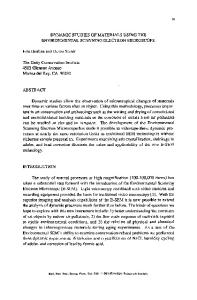Microstructure-Dependent Local Strain Behavior in Polycrystals through In-Situ Scanning Electron Microscope Tensile Expe
- PDF / 641,088 Bytes
- 6 Pages / 593.972 x 792 pts Page_size
- 108 Downloads / 307 Views
I.
INTRODUCTION
FATIGUE variability plays a crucial role in determining the total life of fracture critical turbine engine components. The Air Force Research Laboratory’s Engine Rotor Life Extension and Materials Damage Prognosis programs have examined life-limiting factors in an effort to extend the lives of service components. Various material-specific mechanisms contribute to fatigue variability.[1] For example, fatigue variability has been associated with competing failure mechanisms in Ti-6246, Rene´ 88DT, and IN-100.[2–4] The ability to predict fatigue variability and the minimum life of critical components significantly affects the sustainability of an aircraft fleet. To accurately predict fatigue variability, it is vital to understand what the fatigue-critical microstructural features are and exactly how these may couple with loads and temperatures to nucleate damage in these critical components. It is a commonly held notion that damage nucleates in locations of large strain M.A. TSCHOPP, Visiting Research Scientist, is with the Air Force Research Laboratory, Materials and Manufacturing Directorate, AFRL/RX, Wright Patterson AFB, Dayton, OH 45433, employed by Universal Technology Corporation, Dayton, OH 45433. Contact e-mail: [email protected] B.B. BARTHA, Research Scientist, is with the United Space Alliance, Cape Canaveral AFB, Cape Canaveral, FL 32815. W.J. PORTER, Research Scientist, is with the Air Force Research Laboratory, Materials and Manufacturing Directorate, AFRL/RX, and the University of Dayton Research Institute, Dayton, OH 45431. P.T. MURRAY, Senior Research Engineer, is with the University of Dayton Research Institute. S.B. FAIRCHILD, Senior Research Scientist, is with the Air Force Research Laboratory, Materials and Manufacturing Directorate, AFRL/RXPS. Manuscript submitted February 13, 2009. Article published online August 19, 2009 METALLURGICAL AND MATERIALS TRANSACTIONS A
concentrations or where substantial inelastic deformation exists. Digital image correlation[5–9] is a technique often used at larger scales to investigate how strain localizes around part geometric features, such as cracks, holes, and notches. Recently, this technique has been applied at increasingly smaller scales; i.e., in-situ scanning electron microscope (SEM)[10–14] and atomic force microscope[15–18] studies are now on the order of the underlying microstructural features. For example, Sutton et al.[10,11] used SEM imaging with digital image correlation (DIC) to validate the experimental strain measurement capability over a large range of magnifications. Additionally, Chasiotis and Knauss[16] combined DIC with AFM images to measure the elastic tensile properties of surface-micromachined polysilicon specimens for microelectromechanical systems (MEMS) applications. More recently, Xu et al.[19] have combined DIC with AFM images to map the nanoscale wear field of a gold coating. In order to obtain strains at these scales, it is important to have sufficient contrast in the images to perform DIC, i.e., a speckle pattern in
Data Loading...










